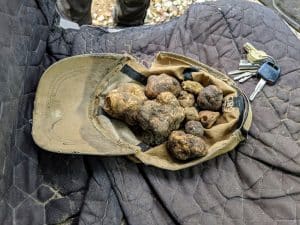The tiniest spot of what looks like a buried egg peers out of the ground. When I lean down, scents of garlic and salami joyously greet my nostrils… It is the white truffle – the world’s most prized food.

In the orange light of a Mediterranean sunrise, I find myself racing through a forest, trying not to wreck myself on a fallen log, while desperately pursuing a small white dog that has just charged ahead and begun to tunnel into the earth at the foot of an oak tree.
My companion, who I’ll call Tomas, is one step ahead of me, beseeching the dog in rapid-fire Croatian. He reaches her first, nudging her out of the way and taking over.
From his pack, he produces a small spade and works it like a surgeon over the growing hole. He scrapes away a millimetre of dirt at a time, then leans down, sniffing. I kneel beside him, peering into the earth for a sign of our quarry.
Tomas calls the dog, Lela, and asks her to check again. She noses the ground once, twice, then scratches at a spot a few inches from his target. He changes his angle and goes deeper. “There it is,” he says at last.
The tiniest spot of what looks like a buried egg peers out of the ground. When I lean down, scents of garlic and salami and amaro liqueur swirl out of the soil.
“Oh, yeah!” I say, jolted by the excitement of the treasure hunt, the relief after slogging through the pre-dawn darkness for two hours, and the sheer desire evoked by the irresistible smell emanating from the earth.
Tomas continues his surgery until the quarry emerges, looking like an off-white meteorite embedded in the earth. He pries the dirt around it, careful not to nick its skin, until he can slide his spade underneath and pop it out of the ground. Then he lifts it to his nose, closes his eyes, and inhales the sweet smell of success. It is the famed white truffle, Tuber magnatum, the world’s most prized food.
Tomas pulls out his phone, snaps a photo, and begins texting dealers in the UK and Germany. Within minutes, he has sold it for €400. And we haven’t even had breakfast yet.
I can’t reveal more specifics – who I’m with, where we are – because those were the conditions of me being allowed to tag along. For the past three years, I’ve been hunting truffles in half a dozen countries for my book, Truffle Hound.
I’ve never encountered a food that floored me the way a truffle does, that has wrapped itself around the core of my consciousness like the thing in Alien and refused to let go, and I’ve found that many others are affected the same way. When it comes to smell, truffles are in a class by themselves.
I’ve also found that everything I thought I knew about them is wrong. The real world of truffles is far more interesting and diverse than the myths, a reality revealed by the details of this scene.
For instance, this is not Italy. Lela isn’t a pig. And most important of all, the maddeningly complex aroma of this fresh truffle bears little resemblance to the musty odour passed off as truffle in the thousands of truffle chips, crisps, and oils on the market, most of which contain no real truffle at all.
From forest to table
Truffles are having a moment. In part, we can thank The Truffle Hunters, the recent documentary that is short on information but long on gorgeous, painterly scenes of old Italian truffle hunters and their dogs – as well as Pig, in which Nicolas Cage plays a burnt-out chef and truffle hunter seeking redemption (and his stolen truffle pig) in Portland, Oregon.
But both films are really indications of a greater awakening, as people discover that the forest-to-table movement has somehow overlooked the greatest forest ingredient of all.
Like mushrooms, truffles are the spore-filled fruiting bodies of fungi that live underground in partnership with tree roots.
The fungi mine minerals and water from the soil and feed them to trees in exchange for sugars, which the trees make through photosynthesis.
Unlike mushrooms, truffles never rise above the surface, so in order to spread their spores, they produce irresistible smells, convincing passing animals to dig them up, eat them, and disperse the spores.
Truffles grow wild in all the world’s forests. There are thousands of different species, but only a handful are culinary gold (to humans, at least). Top are the black winter truffle and the white. French scientists worked out how to cultivate the black winter in the 1970s, and today 95 per cent of the supply is farmed, mostly in Spain.
But no one has ever managed to cultivate the white truffle, which must still be hunted in the wild.
Judging by my experiences, on a good day, you might find half a kilogram, but on many days, you will find nothing. Along with their intense smell, that is why white truffles are so expensive, about €3,000 (£2,500) per kg versus €1,200 for the black winter truffles.
So how can a bottle of truffle oil be sold for just a few pounds? Because it is cheap olive oil flavoured with a synthetic chemical that mimics one of the 50 flavour compounds in a real truffle. The same goes for most other packaged truffle products.
If you’ve been disappointed by the cloying attack of this smell, don’t let it put you off real truffles, which are infinitely more delicate and complex.
They are expensive, but you don’t need much. Just 10 grams are enough to transform your tagliatelle into a masterpiece and leave you with an experience that will be echoing through your memory banks for life.
The scent of success
The only way to find a truffle under the ground is to use an animal with a good nose. Truffling began in ancient times when farmers noticed their pigs rooting up “stinky potatoes” they found in the woods, so pigs were the obvious choice for our truffling partners, but it was always a fraught relationship. Pigs adore truffles, pigs are very large, and pigs are very insistent. Stories abound of nine-fingered truffle hunters.
Although the image of the truffle pig endures, at least in films, virtually no one has used a truffle pig in more than a century. Today, everyone uses dogs: easier to train and easier to squeeze into your passenger seat. And most of them don’t really care about eating the truffles. They work for treats, and love.
And how they work. Watching a top truffle dog in action is a joy. They race through the forest, noses low, zigzagging as they bracket the smell, forming a three-dimensional image of the scent trail in their mind.
Every time I’m convinced a dog is pursuing eau de squirrel instead of truffle, she will suddenly whirl around, charge 20 metres to a random spot, and begin digging.
At least, the good ones will. There are bad truffle dogs, for sure, and there is much debate about which breeds to use. Top of the pack is the poodle-like lagotto Romagnolo, an ancient Italian breed that specialises in truffles. They are smart, energetic and in short supply. For all those reasons, a good one can set you back €5,000.
My impression, however, is that any dog off the street can be trained to truffle hunt, if you get them young and do it right.
“The trick is to make truffle hunting more fun than anything else,” one expert in the US told me. “When they find a truffle, you lavish them with treats. I recommend rib-eye hot off the grill.”
I’ve met brilliant truffle-hunting dachshunds, Jack Russells, chihuahuas, German shepherds and mutts of all stripes. Two of the world’s top truffle dogs are black Labradors – one in Hungary, and one in England.
Where to find them
Perhaps the biggest revelation of my three years on the trail is that good truffles can be found almost everywhere. Although national pride and a desperate desire to hang onto their monopolies has kept France and Italy insisting they have a lock on great black and white truffles, the reality is that most black winter truffles come from Spain, many whites from Eastern Europe and many other amazing varieties can be found around the world.
That should be celebrated. Europe, Asia, Australia and North America all have their great truffles. Like wine grapes, each has its own appeal and regional character that depends on the local bedrock, soil, climate, and tree species.
The old myths and secrecy have suppressed much intelligent exploration of this territory, but that’s changing, which is why there’s never been a more exciting time to be a truffle hound. New species. New regions. New smells.
And better quality than ever before. In the old days, Tomas might have spent a week hunting, then sold his haul to a middleman, who would drive to Italy and sell to a dealer, who would distribute to chefs across Europe. By the time most of those “Italian” truffles reached dinner plates, they’d be a shadow of their former selves. Today, a truffle’s journey from hunter to diner can take just a few days, its origin lovingly preserved.
This, I think, is the bright future of truffles. Expect to see restaurants and food shops offering a variety of fresh truffles from far-flung locales, each with its own unique flavour and story. As with wine, that uniqueness will be celebrated, not obscured. It will include the name of the species, the region, the hunter – and, I hope, the name of the truffle dog who made it all possible.
British truffles
Yes, Britain has truffles. Southern England in particular. They are a different species, known as black autumn or burgundy truffles, and they are very good.
Both grow just beneath the ground surface near beech, hazel, oak and birch trees and are found in the rich soils of chalk downs. They have been found in Surrey, Wiltshire, Dorset, Hampshire, the Chilterns, Somerset, Herefordshire, Oxfordshire, Berkshire and the Isle of Wight as well as in Darlington.
Their flavour is often described as “nutty”.
Be warned, though – according to wildfooduk.com they are “very hard to find without a female pig or trained dog”.
Jacobson recommends englishtruffles.co.uk: “Good for both truffle hunts and for getting your dog trained!”
Truffle Hound: On the Trail of the World’s Most Seductive Scent with Dreamers, Schemers and Some Extraordinary Dogs by Rowan Jacobsen is out now (£20, Bloomsbury)
(Article source: Inews)

